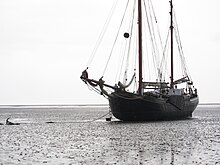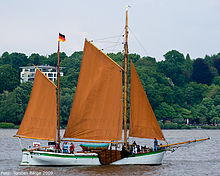Ewer
A ewer is a smaller, from Friesland originating Glider type with flat bottom and one or two masts , originally without keel. One-masted ewer are called stake or giekewer , two-masted are called mizzenewer .
In the case of two-masted Ewern, the aft mizzen mast is significantly shorter than the main mast in front of it . So he's a master and a half . Ewer are gaff rigged . In front of the main mast, the ewer usually drive jib and jib . Typical features are the flat underwater hull and often side swords , with which the drift is reduced on close-wind and half-wind courses . The Ewer in northern Germany are on average 16 meters long and four meters wide.
History, distribution and use
A type of ship called Ewer has been known since the Middle Ages; a first written mention comes from the Flemish-speaking area from the year 1252 and describes the eenvare . In the dictionary of the German language it is suspected that Dutch could mean envarer = ' Einfahr ', which would indicate an original one-man occupation. Jörgen Bracker puts forward a different theory, from his point of view the Ewer are too big for a single-handed sailor . He suspects an origin of var (e) = load or load, so a ewer would be a boat that could transport the load of a four-horse load, usually the weight or mass of 12 large filled tons.
From around 1800 they found distribution mainly in the area of the Lower Elbe and Lower Weser as well as in the Netherlands and Denmark. With over 2000 boats built, they were the most frequently used type of ship in Germany in the 19th century. Most ewer had a lifespan of up to 30 years, only a quarter of the ewer could be used for up to 50 years. They were used in particular as cargo ships in coastal and river navigation, sometimes also as fishing vessels .
The development in the Lower Elbe area can be traced back to the fact that up to 1800, mainly half-decked, single-masted boats with square sails and a raised stem were used. This type of Ewert was not used until 1840. In order to differentiate this Ewert type from the following type, they were subsequently referred to as Pfahlewer .
Regional names were sometimes used for the Ewer, while the Low German term Dreuchewer describes the Trockenewer, i.e. a Ewer without a Bünn , which includes all Ewert types except for the Ewer of fishing:
- Fischerewer (in 1740 there were 60 Fischewer in Blankenese , in 1787 there were 140)
- Bugsierewer
- Ferryman
- Potato maker
Since the beginning of the 20th century, ewer have also been equipped with motors. Later on the rigging was completely dispensed with and the Ewer were only driven with their own engine or as a tow. In northern Germany, the last Ewer built for commercial purposes was completed in 1910.
Preserved copies
| Surname | Construction year | Type | home port | comment |
|---|---|---|---|---|
| Wind bride | 1911 | Alstermaßewer | Stade | |
| Anna - Lisa | 1906 | Alstermaßewer | Wischhafen | |
| Petrine | 1909 | Cargo ship | Hiddensee |

Petrine on the Elbe in front of Kollmar in June 2011
|
| Amazon | 1909 | Cargo ship | Museum harbor Oevelgönne | |
| Johanna | 1903 | Cargo ship | Hamburg | |
| Catarina | 1889 | Fishing ship | Hamburg | |
| Annemarie | 1914 | Cargo ship | Hooge | |
| Gull | 1907 | Cargo ship | Museum harbor Oevelgönne | |
| Elfriede | 1904 | Cargo ship | Museum harbor Oevelgönne | |
| Hermann | 1905 | Cargo ship | Hamburg Harbor Museum | |
| Luise | 1906 | Cargo ship | Goehren (Ruegen) | |
| Alfred | 1913 | Cargo ship | Greifswald | |
| Friedrich | 1910 | Cargo ship | Empty | |
| Jonas of Friedrichstadt | 1911 |

Jonas von Friedrichstadt in the port of Pellworm
|
||
| Maria | 1881 | Fischewer | Munich |

Maria in the Deutsches Museum
|
| Maria af von Hoff | 1981 (replica) | Fischewer | Kappeln |
See also
- Milch-Ewer : small Ewer with which milk products were transported to the cities of Hamburg and Altona
- Ewerführer : Skipper in the port of Hamburg
Web links
Individual evidence
- ↑ a b c Jörgen Bracker: Comments on the construction and equipment of the Hamburger Staatsewer, Schniggen and Huckboot in the light of the Hamburg combing accounts . In: Preserving and reporting: Festschrift for Hans-Dieter Loose on his 60th birthday . Journal of the Association for Hamburg History Volume 83.1, 1997. P. 167 ff
- ^ Hans Szymanski: Die Ever der Niederelbe (1932) . European University Publishing House, Bremen 2011, ISBN 978-3-86741-726-6 , p. 41 .
- ^ Wilfried Botha: blueprints for a Blankeneser Pfahlewers . In: Yearbook of the Altona Museum . tape 1878/1979, 1980 ( deutsche-digitale-bibliothek.de ).
- ↑ Old Pfahlewer from Finkenwerder . In: Guide to the Department of Sea Fisheries . Year 1903 of the messages of the Altonaer Museum, No. 2,3,4 , p. 7th ff . ( deutsche-digitale-bibliothek.de ).











